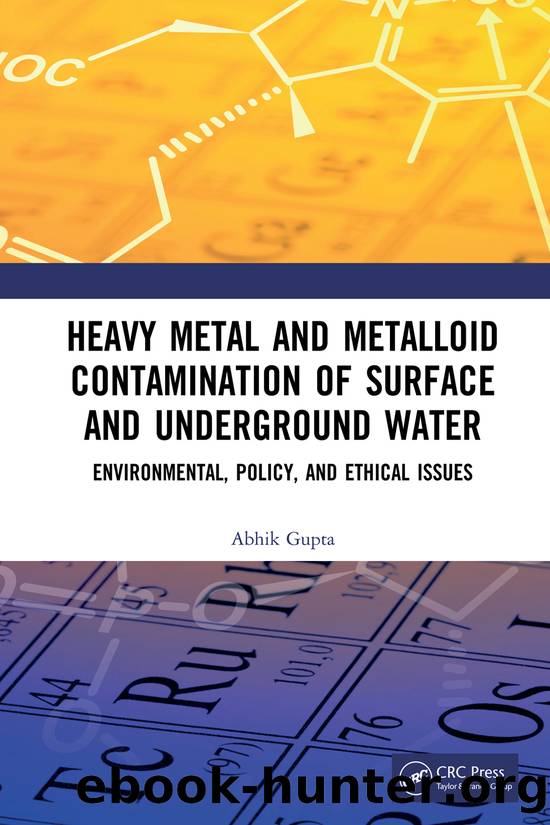Heavy Metal and Metalloid Contamination of Surface and Underground Water by Gupta Abhik;

Author:Gupta, Abhik;
Language: eng
Format: epub
Publisher: Taylor & Francis Group
Published: 2020-08-21T00:00:00+00:00
8ââRemediation of Heavy Metals by Biota
Phytoremediation of Heavy Metal- and Metalloid-Contaminated Water
Phytoremediation has been defined in a number of ways. A very basic and inclusive definition would be: âPhytoremediation basically refers to the use of plants and associated soil microbes to reduce the concentrations or toxic effects of contaminants in the environmentsâ (Greipsson 2011). Tangahu et al. (2011) defined phytoremediation as âthe use of plants to clean up a contamination from soils, sediments, and water.â It is a cost-effective, environment-friendly, and solar-driven technology that mainly comprises phytoextraction (or phytoaccumulation), phytofiltration, phytostabilization, phytovolatilization, phytodegradation, rhizodegradation, and phytodesalinization. Of these, phytoextraction, phytofiltration, phytostabilization, and phytovolatilization are particularly useful in the removal of heavy metals and metalloids. Phytodegradation and rhizodegradation are mostly relevant for organic toxicants, and phytodesalinization for removing salinity or sodium chloride (Ali et al. 2013).
In phytoextraction, there is uptake/absorption of heavy metals/metalloids by the roots followed by translocation into aboveground parts like shoots which can be harvested and burnt to generate energy and recover the metals (Tangahu et al. 2011). In phytofiltration, heavy metals/metalloids are removed by absorption or adsorption from water or wastewater by plants through the processes of rhizofiltration (filtration by roots), blastofiltration (by seedlings), or caulofiltration (by stem or shoot). Among the different strategies or techniques of phytoremediation, removal of heavy metals and metalloids from aqueous medium is best achieved by phytofiltration, perhaps because it involves rhizofiltration, blastofiltration, and caulofiltration to remove heavy metals and metalloids. Though aquatic plants are used in phytofiltration, terrestrial plants in hydroponic solutions are often preferred because of their much larger fibrous root systems covered with extensive root hairs to give them large surface areas for the absorption/adsorption of metallic pollutants. On the other hand, most aquatic plants have small, slow-growing roots which hinder their performance. Whether terrestrial or aquatic, plants used in phytofiltration should be able to tolerate and accumulate high concentrations of heavy metals/metalloids (Padmavathiamma and Li 2007).
In contrast to phytofiltration, phytostabilization is a technique that immobilizes the heavy metals/metalloids, thereby reducing their mobility and bioavailability, and preventing their migration into groundwater or into the food chain (Tangahu et al. 2011; Ali et al. 2013). Phytovolatilization involves uptake of pollutants by plants and their subsequent conversion into volatile forms to eventually expel them into the atmosphere. However, it is mostly applicable for organic pollutants and only mercury among the heavy metals. Further, it does not sequester the pollutant, but releases it back into the atmosphere wherefrom it can once again be deposited (Ali et al. 2013).
Download
This site does not store any files on its server. We only index and link to content provided by other sites. Please contact the content providers to delete copyright contents if any and email us, we'll remove relevant links or contents immediately.
Whiskies Galore by Ian Buxton(41534)
Introduction to Aircraft Design (Cambridge Aerospace Series) by John P. Fielding(32892)
Rewire Your Anxious Brain by Catherine M. Pittman(18314)
Craft Beer for the Homebrewer by Michael Agnew(17936)
Cat's cradle by Kurt Vonnegut(14763)
Sapiens: A Brief History of Humankind by Yuval Noah Harari(13993)
Leonardo da Vinci by Walter Isaacson(12807)
The Tidewater Tales by John Barth(12397)
Underground: A Human History of the Worlds Beneath Our Feet by Will Hunt(11840)
Thinking, Fast and Slow by Kahneman Daniel(11798)
The Radium Girls by Kate Moore(11624)
The Art of Thinking Clearly by Rolf Dobelli(9919)
A Journey Through Charms and Defence Against the Dark Arts (Harry Potter: A Journey Throughâ¦) by Pottermore Publishing(9141)
Mindhunter: Inside the FBI's Elite Serial Crime Unit by John E. Douglas & Mark Olshaker(8707)
Tools of Titans by Timothy Ferriss(7818)
Wonder by R. J. Palacio(7745)
Turbulence by E. J. Noyes(7704)
Change Your Questions, Change Your Life by Marilee Adams(7381)
Nudge - Improving Decisions about Health, Wealth, and Happiness by Thaler Sunstein(7247)
